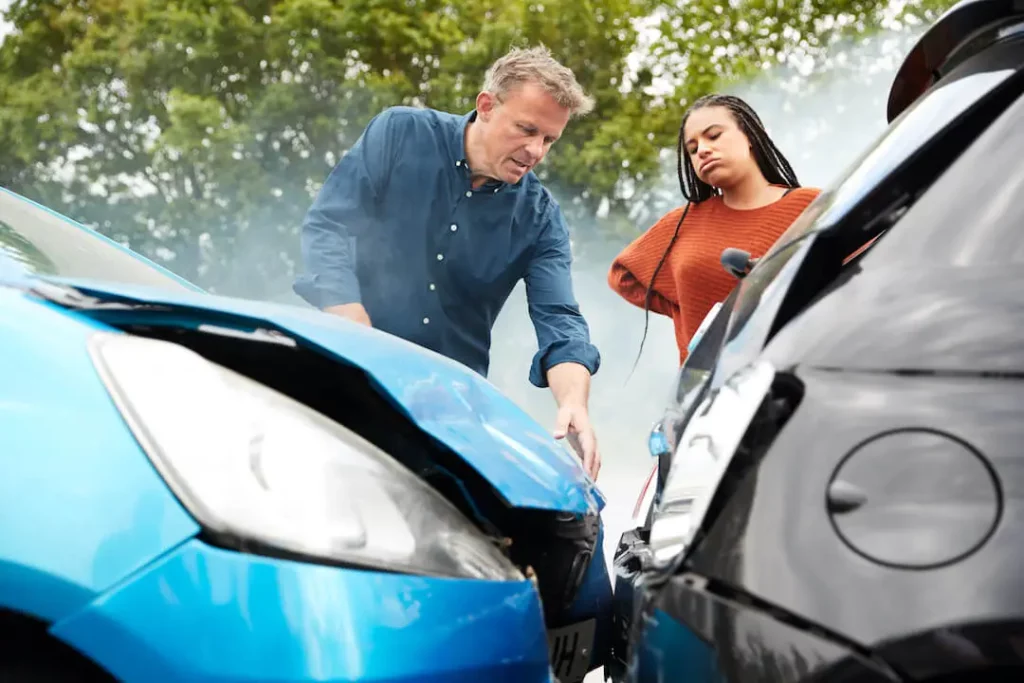When operating a vehicle, it’s important to drive calmly and safely for our sake and others’. According to the Insurance Information Institute, unsafe driving accounted for 66% of fatal vehicle crashes in the USA. Certainly, one way we put ourselves and others at risk of accidents is with offensive driving.
Offensive driving is driving in ways that force other motorists or pedestrians to react. Generally, it’s a group of behaviors requiring defensive maneuvers from others.
This article will unpack what offensive driving looks like, how it differs from defensive driving, and how it becomes aggressive driving.
What Offensive Driving Looks Like
Offensively driving requires other drivers to react to us. It puts others on alert to potentially careless or aggressive behavior on the road.
For example, when we’re running late or simply want to spend less time on the road, the actions required to remedy our problem entail offensive driving. Examples of such actions include:
- Speeding up to shave off time
- Accelerating to make a yellow light
- Taking corners too fast or without looking
- Tailgating the vehicle in front of us
- Making lane changes without adequate space or signaling
- Speeding
- Not yielding the right-of-way
- Driving contrary to what’s warranted by road conditions
- Weaving through traffic
- Running lights and signs
These problems exponentially compound when applied to all the drivers in the country.
Why Offensive Driving Is Dangerous
Offensive driving speeds up the exchanges between ourselves and other motorists, requiring us to make decisions faster than we would otherwise. It shrinks our world to what takes place around our car only and asks other motorists to adjust their expectations to meet ours.
We can’t read other motorists’ minds, and they can’t read ours. We give each other a better chance to understand our intentions when we avoid offensive driving.
Following too closely behind another motorist, for example, pushes our reaction time and our vehicle’s stopping abilities to extremes. We simply cannot stop fast enough.
How To Avoid Driving Offensively
- Take time to arrive safely. Even if we’re already running late, we risk arriving later since any offensive driving procedures can lead to a police officer pulling us over. Or we may run into another car also driven by someone arriving late.
- Get into a positive mindset. Mindset plays a huge role in our driving decisions. If we’re emotional, we’re more likely to make rapid decisions. Our heart rates increase. Our stress levels are higher. We’re prone to negatively react when feeling heavy negative feelings.
- Set our minds to ‘driving mode.’ By doing this, we can anticipate stressful situations in advance, deciding beforehand to handle every situation with extra patience. In doing so, we focus on real control over our actions, ready to make safe decisions.
Offensive Driving vs. Defensive Driving
Defensive driving means anticipating or reacting to other drivers’ decisions before or as they happen.
By contrast, offensive driving increases the need for other drivers to stay more alert. When we drive offensively, we generate more things that drivers around us will have to pay careful attention to.
Suppose we notice another driver who needs to merge into our lane, and we need to make room for them to do so. In that case, defensive driving is choosing to slow down to ensure they have ample room to move over safely. Keep in mind, while it helps to have a positive attitude when driving, defensive driving isn’t about being nice, per se; rather, it emphasizes being safe.

Offensive Driving & Aggressive Driving
Offensive driving and aggressive driving look similar and are often the same.
The NHTSA says aggressive driving is “The operation of a motor vehicle in a manner that endangers or is likely to endanger persons or property.”
Though we may not feel aggressive when driving offensively, our actions communicate aggression to other drivers. They cannot judge whether or not we’re driving offensively or aggressively.
Even if another driver could judge our intent, our actions still force quicker assessments from them. Typically, a quick, forced decision is a rushed, less thoughtful decision. And when we make rushed decisions in several thousand-pound vehicles, we increase the chances of an accident.
Offensive Driving & Insurance Rates
Offensive driving increases the risk of an accident, increasing insurance rates, not to mention out-of-pocket expenses. All the more reason to avoid such behavior, especially considering that Insurify.com projects average auto insurance rates to increase another 5% in 2022, up from the 12% increase in 2021.
In preparing for this article, we spoke personally to insurance agency owner Dave Hill, who had this to say:
“We have a higher frequency of accidents, more damage per accident, and the increasing price of automobiles and automobile parts. All of which cause insurance to go up.
“Speed is the number one factor in accidents because it cuts down on reaction time for people. Anyone else having to deal with that reaction will have to swerve or slam on the breaks.
“Distracted driving is the number two factor. That’s usually texting. If we’re distracted and have to take an exit last minute, we may cut someone off. These little factors, like overestimating our abilities and failing to yield, make a big difference.
“It seems like people don’t follow common courtesy on the road. Not even necessarily the laws, but just paying attention.”

Offensive Driving Questions & Answers
You’ve got questions, we’ve got answers. Here are some commonly asked questions about offensive driving.
What Is the Difference Between Offensive Driving and Aggressive Driving?
Aggressive driving is a form of offensive driving that endangers us, other drivers, or property. Offensive driving, at its core, lends itself to aggressive driving because it emphasizes what we want to happen on the road, irrespective of actual driving conditions.
Whenever we drive offensively, we’re practicing an attitude of self over others in a space that cannot accommodate that attitude. On private land, without anything else in sight, we have the freedom to drive however we wish.
When on public roads that we share with other motorists, we don’t have the freedom to drive any way we please. We must abide by the rules and regulations when traveling on publicly-funded-and-shared roads, lest we risk the consequences, like getting a ticket or causing an accident.
Why Should We Drive Defensively?
We should drive defensively because planning helps mitigate driving problems. Other drivers are likely to act in unpredictable ways, and defensive driving requires taking steps to avoid reacting to other drivers and reacting safely when necessary.
The National Highway Traffic Safety Administration (NHTSA) found that “The fatality rate for the first half of 2021 increased to 1.34 fatalities per 100 million VMT [vehicle miles traveled], up from the projected rate of 1.28 fatalities per 100 million VMT in the first half of 2020.”
Do We Need To Drive Offensively on an Empty Road?
You do need to drive offensively on an empty road, as related driving dangers aren’t limited to other motorists. Animals also run the risk of collision with a vehicle. Ultimately, driving safely at slower speeds allows additional time to react to animals on the road.
According to a Federal Highway Administration study, “[…] there are an estimated one to two million collisions between cars and large animals every year in the United States. This presents a real danger to human safety as well as wildlife survival.”
Conclusion
Safe arrival is our number one goal when driving, and offensive driving impedes this goal. By taking the time to drive carefully, we can reduce accidents, injury to people, property damage, insurance rates, and even taxpayer costs.
Thanks for reading!
If you enjoyed this article about offensive driving, you may want to read about The Difference Between Down Syndrome and Autism Explained, and Why is Mental Health Important for Students: Reasons & Tips.
Sources
- Insurance Information Institute: Facts + Statistics: Aggressive driving
- National Highway and Traffic Safety Association: USDOT Releases New Data Showing That Road Fatalities Spiked in First Half of 2021
- National Highway and Traffic Safety Association: Contributing Factors To Aggressive Driving
- Insurify: Insuring the American Driver
- Federal Highway Administration Research and Technology: Wildlife-Vehicle Collision Reduction Study: Report To Congress

About The Author
M.D Mark D. is a Health and Wellness professional writer. Mark has authored many health articles around the following topics: Men’s Health, Women’s Health, Fitness, Nutrition, Pets Health, Mental Health, Medicine, and Supplements.